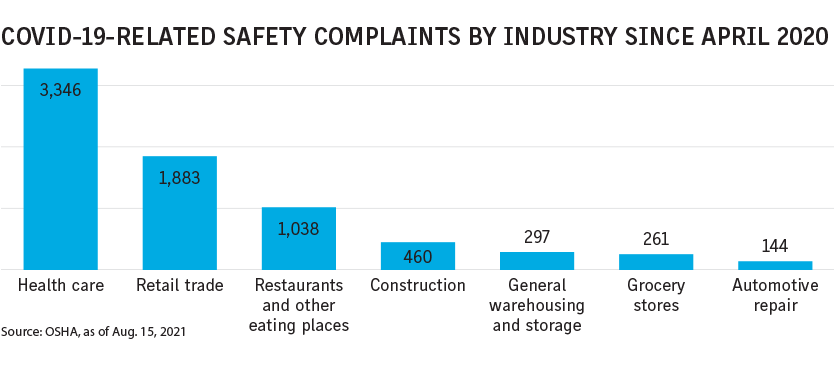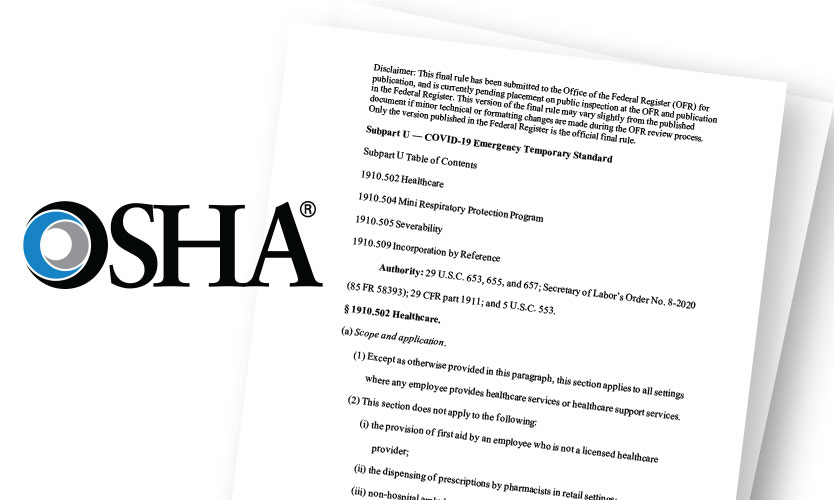Guidance on masks, virus testing toughens
Reprints
Seventeen days after the U.S. Centers for Disease Control and Prevention issued guidance that vaccinated individuals need to wear face masks in areas of high virus transmission, the Occupational Safety and Health Administration followed suit with new recommendations echoing those of the CDC.
Experts were not surprised but the move, which came less than two months after OSHA told employers they could relax masking requirements for vaccinated workers, and said employers should be prepared for more change as they manage workplace safety amid the pandemic.
“Everybody is struggling right now with masks and mandates, and what to do,” said Sean Scullen, Milwaukee-based partner and national chair of the labor and employment group at Quarles & Brady LLP, adding that OSHA’s shifting rules have been problematic. “But to be fair to OSHA, the CDC is all over the place.”
OSHA’s new guidance, issued Aug. 13, said new evidence led CDC on July 27 to update its recommendations for fully vaccinated people to reduce their risk of becoming infected with the Delta variant and potentially spreading it to others. In addition to masks for all in localities with high rates of transmission of COVID-19, OSHA as of August called for all individuals regardless of vaccination status to get tested following a known exposure to someone with suspected or confirmed COVID-19, among other revised guidance.

The guidance falls short of what legal experts and employers had originally been expecting: an emergency temporary standard to cover all workplaces, which President Joe Biden had called on OSHA to establish if determined necessary. Instead, OSHA created an ETS that applied to health care settings only (see related story, below.)
While OSHA said its latest recommendations for all industries are “advisory in nature” and “intended to assist employers in providing a safe and healthful workplace free from recognized hazards that are causing or likely to cause death or serious physical harm,” legal experts say workplaces need to maintain their safety measures or face steep OSHA fines under the agency’s general duty clause, a catch-all mandate that requires employers to provide safe workplaces.
“OSHA continues to cite employers under the general duty clause,” said Andrew Brought, an attorney in the OSHA practice at Spencer Fane LLP in Kansas City, Missouri.
As of Jan. 14 — the last time OSHA provided data on COVID-19-related inspections — the agency had issued $4 million in penalties. While most citations have been issued to medical facilities for violations of specific standards such as respiratory protection — failing to provide adequate masks for health care workers, for example — the general duty clause has also been the basis for fines issued to businesses since the start of the pandemic.
“Everybody knows about the general duty clause, or at least they have learned about it because of COVID,” said Adam Kemper, Fort Lauderdale, Florida-based partner with Kelley Kronenberg LLP. “And that has triggered most of the inspections.”
The general duty clause is “a reasonable person test — did you have reason to believe that safety measures were recognized and feasible?” said Eric Conn, Washington-based founding partner of Conn Maciel Carey LLP. “And that is tracking and following the CDC. … In my view as the CDC goes, so goes OSHA.”
The situation for employers is “constantly evolving,” said Mini Kapoor, a Houston-based associate and OSHA litigator with Haynes Boone LLP. “It’s a very tough time for employers” who also have to comply with local guidance.
“There is not one message except that it is always good to err on the cautious side,” she said. “The clients who have taken the cautious approach are in a better state.”
“As long as an employer has some viable plan for safety in the workplace regarding COVID — contact tracing, isolation for workers who test positive … that is going to go a long way in satisfying OSHA as it relates to COVID,” Mr. Scullen said.
And while a COVID-19 standard that would affect all workplaces is off the table — for now at least, as some legal experts say the summer surge in Delta variant cases could prompt OSHA to consider another ETS — signs point to 2022 as the year the agency reignites its work on a stalled infectious disease standard.
OSHA’s proposed budget for 2022 calls for a 50% increase for rulemaking processes.
The process of creating an infectious disease standard began in 2010 and stalled in 2014.
John Ho, Norwalk, Connecticut-based labor and employment attorney and chair of the OSHA practice at Cozen O’Connor, said the normal rulemaking process for creating a standard is the way to go, instead of the ETS process, as it requires public hearings to implement.
“It’s not rushed and you give stakeholders an opportunity to comment. That’s the way it should normally go,” he said.

Safety standard addresses health care sector risks
The Occupational Safety and Health Administration in June released the details of its long-awaited Emergency Temporary Standard, which it says will only apply to workers in a health care setting.
The ETS includes such requirements as sanitation, time off for illness or vaccinations, antiretaliation measures and personal protective equipment while working with COVID-19 patients and closely resembles rules set in place by the U.S. Centers for Disease Control and Prevention.
While worker advocates were expecting an ETS to apply to all industries, OSHA said its scaled-down version was in line with science, with Secretary of Labor Marty Walsh stating during a media briefing on June 10 that “the science tells us that health care workers, particularly those who come in regular contact with the virus, are most at risk in the pandemic.”
The 44-page standard provides details on mask-wearing and other PPE, notification and tracking requirements for workers who have been exposed to COVID-19, precautions for unvaccinated workers, and requirements that health care settings have in place a drafted COVID-19 safety plan. The standard also calls for employers in health care settings to encourage staff vaccinations.
Read Next
-

High courts clarify how after-the-fact events affect workers comp coverage decisions
Hindsight is said to be 20/20, but sometimes the changes that come with the passage of time bring complications instead of clarity. Supreme courts in three states recently weighed in on cases where after-the-fact events affected a worker’s claim. Vermont’s highest court addressed how to handle a change in law that happened after a worker filed his claim. The Pennsylvania Supreme Court clarified the statute of limitations for a firefighter stricken by cancer after his retirement, while Oregon’s top court explained an employer’s obligation to reopen a claim after its denial has been set aside.